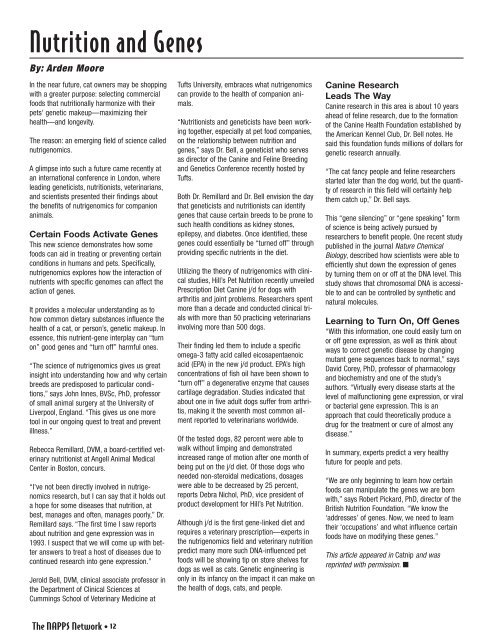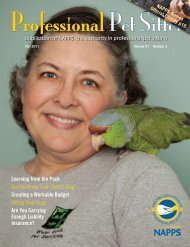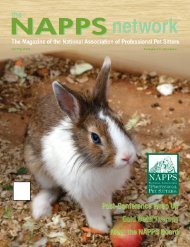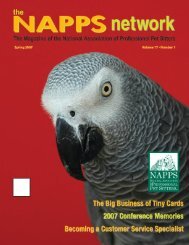Spring 2009 - National Association of Professional Pet Sitters
Spring 2009 - National Association of Professional Pet Sitters
Spring 2009 - National Association of Professional Pet Sitters
Create successful ePaper yourself
Turn your PDF publications into a flip-book with our unique Google optimized e-Paper software.
Nutrition and Genes<br />
By: Arden Moore<br />
In the near future, cat owners may be shopping<br />
with a greater purpose: selecting commercial<br />
foods that nutritionally harmonize with their<br />
pets' genetic makeup—maximizing their<br />
health—and longevity.<br />
The reason: an emerging field <strong>of</strong> science called<br />
nutrigenomics.<br />
A glimpse into such a future came recently at<br />
an international conference in London, where<br />
leading geneticists, nutritionists, veterinarians,<br />
and scientists presented their findings about<br />
the benefits <strong>of</strong> nutrigenomics for companion<br />
animals.<br />
Certain Foods Activate Genes<br />
This new science demonstrates how some<br />
foods can aid in treating or preventing certain<br />
conditions in humans and pets. Specifically,<br />
nutrigenomics explores how the interaction <strong>of</strong><br />
nutrients with specific genomes can affect the<br />
action <strong>of</strong> genes.<br />
It provides a molecular understanding as to<br />
how common dietary substances influence the<br />
health <strong>of</strong> a cat, or person’s, genetic makeup. In<br />
essence, this nutrient-gene interplay can “turn<br />
on” good genes and “turn <strong>of</strong>f” harmful ones.<br />
“The science <strong>of</strong> nutrigenomics gives us great<br />
insight into understanding how and why certain<br />
breeds are predisposed to particular conditions,”<br />
says John Innes, BVSc, PhD, pr<strong>of</strong>essor<br />
<strong>of</strong> small animal surgery at the University <strong>of</strong><br />
Liverpool, England. “This gives us one more<br />
tool in our ongoing quest to treat and prevent<br />
illness.”<br />
Rebecca Remillard, DVM, a board-certified veterinary<br />
nutritionist at Angell Animal Medical<br />
Center in Boston, concurs.<br />
“I've not been directly involved in nutrigenomics<br />
research, but I can say that it holds out<br />
a hope for some diseases that nutrition, at<br />
best, manages and <strong>of</strong>ten, manages poorly,” Dr.<br />
Remillard says. “The first time I saw reports<br />
about nutrition and gene expression was in<br />
1993. I suspect that we will come up with better<br />
answers to treat a host <strong>of</strong> diseases due to<br />
continued research into gene expression.”<br />
Jerold Bell, DVM, clinical associate pr<strong>of</strong>essor in<br />
the Department <strong>of</strong> Clinical Sciences at<br />
Cummings School <strong>of</strong> Veterinary Medicine at<br />
Tufts University, embraces what nutrigenomics<br />
can provide to the health <strong>of</strong> companion animals.<br />
“Nutritionists and geneticists have been working<br />
together, especially at pet food companies,<br />
on the relationship between nutrition and<br />
genes,” says Dr. Bell, a geneticist who serves<br />
as director <strong>of</strong> the Canine and Feline Breeding<br />
and Genetics Conference recently hosted by<br />
Tufts.<br />
Both Dr. Remillard and Dr. Bell envision the day<br />
that geneticists and nutritionists can identify<br />
genes that cause certain breeds to be prone to<br />
such health conditions as kidney stones,<br />
epilepsy, and diabetes. Once identified, these<br />
genes could essentially be “turned <strong>of</strong>f” through<br />
providing specific nutrients in the diet.<br />
Utilizing the theory <strong>of</strong> nutrigenomics with clinical<br />
studies, Hill’s <strong>Pet</strong> Nutrition recently unveiled<br />
Prescription Diet Canine j/d for dogs with<br />
arthritis and joint problems. Researchers spent<br />
more than a decade and conducted clinical trials<br />
with more than 50 practicing veterinarians<br />
involving more than 500 dogs.<br />
Their finding led them to include a specific<br />
omega-3 fatty acid called eicosapentaenoic<br />
acid (EPA) in the new j/d product. EPA’s high<br />
concentrations <strong>of</strong> fish oil have been shown to<br />
“turn <strong>of</strong>f” a degenerative enzyme that causes<br />
cartilage degradation. Studies indicated that<br />
about one in five adult dogs suffer from arthritis,<br />
making it the seventh most common ailment<br />
reported to veterinarians worldwide.<br />
Of the tested dogs, 82 percent were able to<br />
walk without limping and demonstrated<br />
increased range <strong>of</strong> motion after one month <strong>of</strong><br />
being put on the j/d diet. Of those dogs who<br />
needed non-steroidal medications, dosages<br />
were able to be decreased by 25 percent,<br />
reports Debra Nichol, PhD, vice president <strong>of</strong><br />
product development for Hill’s <strong>Pet</strong> Nutrition.<br />
Although j/d is the first gene-linked diet and<br />
requires a veterinary prescription—experts in<br />
the nutrigenomics field and veterinary nutrition<br />
predict many more such DNA-influenced pet<br />
foods will be showing tip on store shelves for<br />
dogs as well as cats. Genetic engineering is<br />
only in its infancy on the impact it can make on<br />
the health <strong>of</strong> dogs, cats, and people.<br />
Canine Research<br />
Leads The Way<br />
Canine research in this area is about 10 years<br />
ahead <strong>of</strong> feline research, due to the formation<br />
<strong>of</strong> the Canine Health Foundation established by<br />
the American Kennel Club, Dr. Bell notes. He<br />
said this foundation funds millions <strong>of</strong> dollars for<br />
genetic research annually.<br />
“The cat fancy people and feline researchers<br />
started later than the dog world, but the quantity<br />
<strong>of</strong> research in this field will certainly help<br />
them catch up,” Dr. Bell says.<br />
This “gene silencing” or “gene speaking” form<br />
<strong>of</strong> science is being actively pursued by<br />
researchers to benefit people. One recent study<br />
published in the journal Nature Chemical<br />
Biology, described how scientists were able to<br />
efficiently shut down the expression <strong>of</strong> genes<br />
by turning them on or <strong>of</strong>f at the DNA level. This<br />
study shows that chromosomal DNA is accessible<br />
to and can be controlled by synthetic and<br />
natural molecules.<br />
Learning to Turn On, Off Genes<br />
“With this information, one could easily turn on<br />
or <strong>of</strong>f gene expression, as well as think about<br />
ways to correct genetic disease by changing<br />
mutant gene sequences back to normal,” says<br />
David Corey, PhD, pr<strong>of</strong>essor <strong>of</strong> pharmacology<br />
and biochemistry and one <strong>of</strong> the study’s<br />
authors. “Virtually every disease starts at the<br />
level <strong>of</strong> malfunctioning gene expression, or viral<br />
or bacterial gene expression. This is an<br />
approach that could theoretically produce a<br />
drug for the treatment or cure <strong>of</strong> almost any<br />
disease.”<br />
In summary, experts predict a very healthy<br />
future for people and pets.<br />
“We are only beginning to learn how certain<br />
foods can manipulate the genes we are born<br />
with,” says Robert Pickard, PhD, director <strong>of</strong> the<br />
British Nutrition Foundation. “We know the<br />
‘addresses’ <strong>of</strong> genes. Now, we need to learn<br />
their ‘occupations’ and what influence certain<br />
foods have on modifying these genes.”<br />
This article appeared in Catnip and was<br />
reprinted with permission. ■<br />
The NAPPS Network • 12








